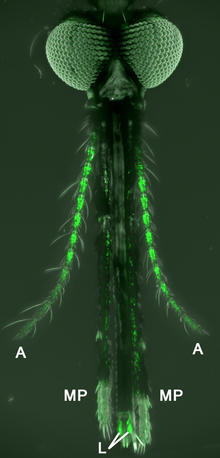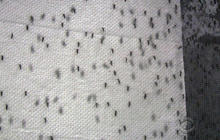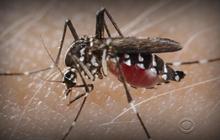New way to fight mosquitoes focuses on human "flavors"
Rather than spraying neighborhoods with pesticides or dousing ourselves with chemical repellents to ward off mosquitoes, wouldn’t it be great if the insects simply didn’t like how humans tasted and left us alone?
That’s the concept behind some new research from scientists at Johns Hopkins University. They’re studying how the brains of mosquitoes process tastes and smells, in hopes of identifying a way to make “human flavor” distasteful to mosquitoes.
Their work, published online in the journal Nature Communications, focuses on Anopheles gambiae, a type of mosquito that carries malaria, an illness that kills about 438,000 people around the world each year and sickens more than 200 million.
The research not only suggests a possible path to a malaria-free future, but it hints at ways other mosquito-borne illnesses, like the Zika virus, could ultimately be combatted.
Malaria is transmitted to humans and animals by the female Anopheles mosquito. Even though the disease is curable in its early stages, treatment is expensive and hard to deliver to many of the places where it is endemic, experts say.

A female Anopheles gambiae mosquito with olfactory neurons on the antennae (A), maxillary palp (MP), and labella (L), highlighted in green.
The researchers behind the study zeroed in on the fact that mosquitoes use their sense of smell to find a host for a “blood meal.” (Yes, just in time for Halloween, it does sound kind of scary and gross.)
Mosquitoes have three pairs of “noses” that they use to detect odors – two labella, two maxillary palps, and two antennae. Basically, each “nose pair” has a different function. The maxillary palps, which shoot out from the lower part of the insect’s head, are parallel to the proboscis, the covering for the animal’s long recognizable “feeding needle.” The labella are located at the proboscis’s tip, and these contain the neurons that receive tastes and neurons for recognizing odors.
The goal of the study was to see how the mostquitoes’ brains received this information. To do this, the scientists used a method never accomplished with mosquitoes before that makes specific neurons glow green.
“We have introduced a new genetic technology into mosquitoes called the ‘Q-system.’ I had previously developed the Q-system for use in another insect, the fruitfly Drosophila melanogaster, and it worked very well. So we though we would also try to introduce these tools into the Anopheles system,” study author Christopher Potter, Ph.D., assistant professor of neuroscience at the Johns Hopkins University School of Medicine, wrote in an email to CBS News.
“We were able to isolate and utilize the region in Anopheles genome that gives rise to expression in the smell neurons. This had never been tried before. And finally, we were able to generate new strains of Anopheles gambiae by injecting this DNA into their eggs… this is technically very challenging. So all together, we overcame many technical hurdles while also introducing a new set of genetic tools into the Anopheles mosquito.”
What was the result? Well, Potter and his team found that odorant receptor (OR) neurons from the antennae and maxillary palps went to the antennal lobes in the mosquito brain. This is what happens in the brain of a fly. What was different with this experiment was that the labellas’ OR neurons traveled to an area that has never been associated with the sense of smell in any insect. This area — the subesophegeal zone — had solely been attached to taste.

Brazilian town fighting Zika virus with more mosquitoes
Millions of genetically-modified mosquitoes are being released in the Brazilian town of Piracicaba with the hope that they’ll take out Zika-infec…
What that means, they believe, is that mosquitoes aren’t just attracted by human smells but also by our “flavor.” And that could open up new possibilities for combatting the insects.
The “glowing” neurons created by Potter could make it easier for researchers to breed genetically altered mosquitoes that would develop new traits.
“Our research allows us to look at the mosquito nose in unprecedented detail. So the next phase is to now use this new ability to see the Anopheles smell neurons, and directly see which ones are activated (turned on) or inhibited (turned-off) by repellants. We know surprisingly little about how repellants actually work… that is, what they are doing to the mosquito’s smell neurons that keeps the mosquito away from us. So our goal is to identify better, safer, and more effective insect repellants by understanding how insect repellants actually affect the mosquito’s nose,” Potter wrote.

Mosquitoes: “The most murderous animal on Earth”
“Once we figure that out, then we can take a rational scientific approach to rapidly screen for new chemicals and odorants that affect the mosquito’s nose in a way that strongly predicts that it will work as a mosquito repellant. The next step is to try these odors or chemicals in semi-field tests, see how well they work, and hopefully bring some of the best ones to the world.”
Ultimately, the hope is to discover a solution that is “safe and pleasant-smelling for us but strongly repellant to mosquitoes at very low concentrations,”Potter noted in a university press release.
Of course, with the Zika virus making headlines and starting to spread in the U.S., it is natural to wonder if this approach could also work on Aedes aegypti, the species of mosquito that carries that disease. Potter said it’s possible.
“Yes, it is possible that insect repellants that keep Anopheles mosquitoes away may also work on other types of mosquitoes, like the Aedes mosquitoes that carry Zika and Dengue viruses. It should also be possible to introduce these same new genetic tools into Aedes aegypti to directly look at their smell neurons,” he wrote.
Though mosquitoes have bedeviled humans throughout history, this research suggests that we are only now starting to closely understand their physiology and how to harness that knowledge to combat the dangerous diseases mosquitoes can carry.
“Our work is really the tip of the iceberg on what we can now start doing with mosquitoes,” Potter added. “It allows us to start developing a better understanding of how mosquitoes find us. Not just through their noses, but also with their eyes, their sense of taste, and their ability to sense heat. All together, this should allow us to come up with many different new ways to stop mosquito bites, and thus the spread of disease.”
